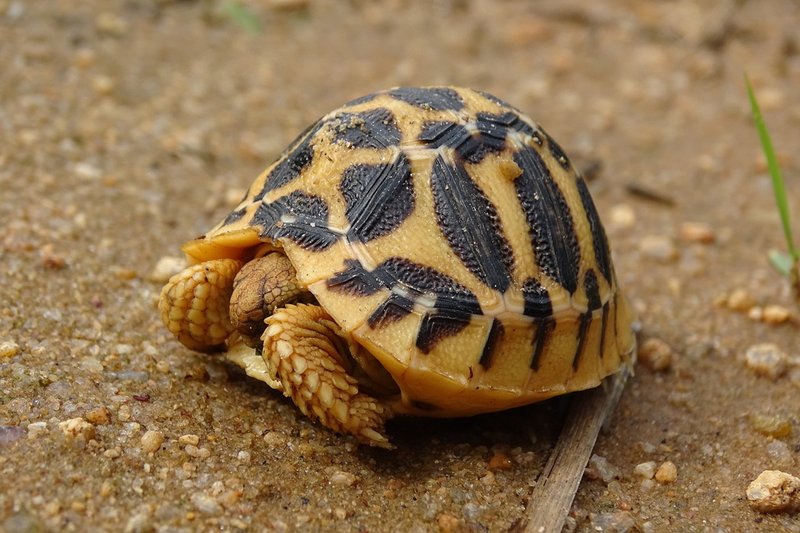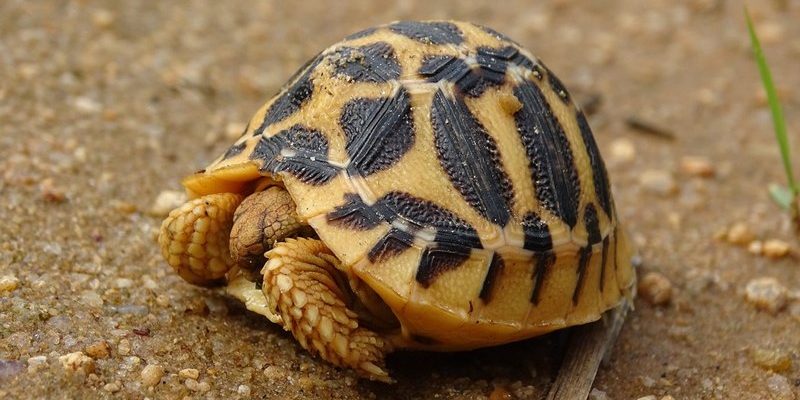
The Indian Star Tortoise is more than just a reptile; it’s a captivating creature with a striking presence. With its distinctive star-patterned shell, this tortoise is one of nature’s most beautiful designs. Imagine walking through lush forests in India and stumbling upon this vibrant little gem, basking in the sun. Just seeing one in its natural habitat can feel like discovering treasure!
These tortoises are not only visually appealing but also have fascinating behaviors and traits that make them unique. They thrive in specific environments and have particular dietary needs that reflect their natural lifestyle. So, whether you’re a wildlife enthusiast or just curious about these remarkable reptiles, let’s dive deeper into the world of the Indian Star Tortoise.
What is the Indian Star Tortoise?
The Indian Star Tortoise (Geochelone elegans) is a medium-sized tortoise native to the dry areas of India and Sri Lanka. Its most easily recognizable feature is, of course, its shell, which is adorned with star-like patterns that radiate out from the center. This not only serves an aesthetic purpose but plays a role in camouflage, helping the tortoise blend into its rocky surroundings.
This tortoise can grow to an average shell length of about 12 to 15 inches, although some individuals can become larger. On the whole, they reach their mature size by the age of 8-15 years. When it comes to lifespan, these tortoises can live for several decades—often between 50 and 100 years—making them long-term companions for pet owners.
Habitat and Distribution
Indian Star Tortoises thrive in a variety of habitats, primarily in dry forests, scrublands, and even grasslands. They’re typically found in India, particularly in the southern regions, and parts of Sri Lanka. The environment is essential for their survival, as it provides the necessary vegetation and shelter.
Within their habitats, they prefer areas with plenty of places to hide from predators. During the day, you may find them basking in the sun, but they’ll seek shelter during the hottest parts of the day. In the wild, their keen ability to camouflage helps them avoid becoming prey to birds and larger mammals.
Diet and Feeding Habits
The diet of an Indian Star Tortoise is primarily herbivorous, consisting of a variety of grasses, flowers, and leafy greens. These tortoises are particularly fond of hibiscus flowers and dandelions. A diverse diet is crucial for their health, keeping their shells strong and their bodies functioning optimally. Just as we need a balanced diet, so do these tortoises.
In captivity, it’s important to mimic their natural diet as closely as possible to prevent health issues. This means offering a mix of leafy greens, vegetables, and occasional fruits. However, it’s vital to avoid feeding them certain foods that are toxic to them, such as spinach and rhubarb. Always keep water available for hydration, as it plays a key role in keeping them healthy.
Behavior and Social Structure
Indian Star Tortoises exhibit some interesting behaviors. They are generally solitary creatures, often enjoying their own space. However, during mating season, males can become quite vocal and assertive as they vie for the attention of females. You might even hear them making sounds or engaging in some gentle pushing and shoving to establish territory.
These tortoises are also known for their active foraging habits. They spend a significant part of their day searching for food, which can take them far from their initial basking spots. Their keen sense of smell helps them locate tasty treats in the wild, making them quite resourceful.
Conservation Status
Unfortunately, the Indian Star Tortoise is considered vulnerable due to habitat loss and illegal poaching. Their stunning shells have made them targets in the illegal pet trade, which poses a significant threat to their populations. Conservation efforts are underway to protect them, but awareness and action are needed.
Preserving their natural habitat is crucial for ensuring their survival. Many organizations are working toward protecting these tortoises and educating the public about their ecological importance. Supporting these initiatives is a way every individual can contribute to the future of the Indian Star Tortoise.
Caring for Indian Star Tortoises as Pets
If you’re thinking about keeping an Indian Star Tortoise as a pet, it’s essential to understand their specific needs. These tortoises require a spacious habitat that mimics their natural environment as closely as possible. A large enclosure with proper ventilation, UV lighting, and a substrate that allows digging is ideal.
Temperature control is another important factor. They need a warm basking area and a cooler area within their habitat to regulate their body temperature. Maintaining the right humidity levels is essential, too, as it helps with their overall health and well-being.
Interesting Facts about Indian Star Tortoises
| Common Name: | Indian Star Tortoise |
| Scientific Name: | Geochelone elegans |
| Size: | 12 to 15 inches |
| Lifespan: | 50 to 100 years |
| Diet: | Herbivorous (grasses, flowers, leafy greens) |
| Habitat: | Dry forests and scrublands |
Myths and Misconceptions
Like many animals, the Indian Star Tortoise has its share of myths surrounding it. One common misconception is that these tortoises are low-maintenance pets; however, they require significant commitment and care. Another myth is that they can live happily in small enclosures, which is far from the truth. They need space to roam and explore, just like they would in the wild.
Understanding these misconceptions is crucial for anyone considering adopting one of these tortoises. Just because they are beautiful doesn’t mean their care will be effortless. It’s essential to be informed and prepared before bringing one into your home.
Health and Common Issues
Indian Star Tortoises may face various health issues, especially if their care isn’t optimal. Some common ailments include respiratory infections, shell rot, and dietary deficiencies. Recognizing early signs of illness can be challenging, so regular check-ups with a veterinarian who specializes in reptiles are crucial.
Diet plays a significant role in their health. A poor diet can lead to obesity or metabolic bone disease, so monitoring their food intake and ensuring variety is vital. Additionally, proper hygiene in their living space ensures they remain clean and reduces the risk of infections.
Breeding Indian Star Tortoises
Breeding Indian Star Tortoises requires careful planning and a suitable environment. Mating occurs during specific seasons, and females can lay eggs multiple times a year. Once the eggs are laid, they require specific temperatures and humidity levels for successful incubation.
Understanding the breeding process is essential for anyone looking to breed these tortoises responsibly. If done correctly, it can be fulfilling to witness the hatching of baby tortoises. However, it’s also vital to ensure you have homes lined up for the hatchlings, as they can multiply quickly!
In Conclusion
To wrap it up, the Indian Star Tortoise is truly an extraordinary creature, capturing the hearts of many with its unique appearance and gentle demeanor. But it’s also a species that faces challenges, from habitat loss to illegal poaching. By learning about their needs and supporting conservation efforts, we can all do our part to protect this wonderful species.
Whether you’re considering one for a pet or just appreciate their beauty in the wild, understanding the Indian Star Tortoise enriches our appreciation for the natural world. So, the next time you think of tortoises, remember this little star and the role we play in ensuring its future!
FAQ
What is the average size of an Indian Star Tortoise?
Typically, an Indian Star Tortoise can grow to an average size of 12 to 15 inches in shell length. However, some individuals may reach larger sizes, depending on their diet and habitat conditions. In captivity, proper care can support healthy growth.
How long do Indian Star Tortoises live?
These tortoises have a remarkably long lifespan, averaging between 50 to 100 years. With proper care, diet, and a healthy habitat, they can thrive for many decades, making them a long-term commitment for pet owners.
Are Indian Star Tortoises good pets?
Indian Star Tortoises can be great pets, but they require specific care and attention. Their diet, habitat, and social needs differ from typical pets. It’s essential to research thoroughly before deciding to adopt one to ensure you can meet their needs.
How can I help protect Indian Star Tortoises?
You can contribute to the protection of Indian Star Tortoises by supporting conservation initiatives, spreading awareness about their plight, and ensuring you do not purchase them from illegal sources. Educating others about their ecological importance is also beneficial.
What is the best diet for an Indian Star Tortoise?
A healthy diet for an Indian Star Tortoise includes a variety of grasses, leafy greens, and flowers. Avoid feeding them toxic plants, such as spinach and rhubarb, and ensure they have access to fresh water for hydration.
Do Indian Star Tortoises need a lot of space?
Yes, Indian Star Tortoises require ample space to roam and explore. A small enclosure is inadequate for their well-being. Ideally, they should have a spacious habitat that mimics their natural environment, allowing them to engage in their natural behaviors.
Can you breed Indian Star Tortoises in captivity?
Breeding Indian Star Tortoises in captivity is possible but requires knowledge and experience. Understanding their natural breeding behaviors, creating suitable nesting conditions, and properly caring for hatchlings are crucial for a successful breeding program.
What are the signs of an unhealthy Indian Star Tortoise?
Signs of an unhealthy Indian Star Tortoise can include lethargy, loss of appetite, respiratory issues (such as wheezing or nasal discharge), and changes in their shell condition. Regular veterinary check-ups can help identify and address health concerns early.
Is it legal to own an Indian Star Tortoise?
The legality of owning an Indian Star Tortoise varies by region, as they are protected under wildlife conservation laws in many areas. It’s essential to check local regulations and ensure you are obtaining your tortoise from a legal and ethical source.
What temperature should I maintain for my Indian Star Tortoise?
Maintaining a temperature gradient in their habitat is essential. The basking area should be between 90°F to 95°F, while the cooler areas should be around 75°F to 80°F. This allows the tortoise to thermoregulate effectively.
How often should I take my Indian Star Tortoise to the vet?
Regular veterinary check-ups are recommended at least once a year for healthy tortoises. If you notice any changes in behavior, diet, or appearance, it’s important to consult a vet sooner to address any potential health issues.

